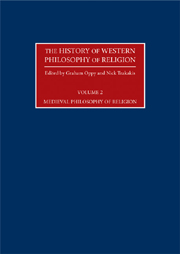Book contents
- Frontmatter
- Contents
- Editorial Introduction
- Contributors
- 1 Medieval Philosophy of Religion: An Introduction
- 2 Boethius
- 3 Johannes Scottus Eriugena
- 4 Al-Farabi
- 5 Avicenna (Ibn Sina)
- 6 Anselm of Canterbury
- 7 Al-Ghazali
- 8 Peter Abelard
- 9 Bernard of Clairvaux
- 10 Averroes (Ibn Rushd)
- 11 Moses Maimonides
- 12 Roger Bacon
- 13 Thomas Aquinas
- 14 John Duns Scotus
- 15 William Ockham
- 16 Gersonides
- 17 John Wyclif
- 18 Nicholas of Cusa
- 19 Erasmus of Rotterdam
- Chronology
- Bibliography
- Index
1 - Medieval Philosophy of Religion: An Introduction
- Frontmatter
- Contents
- Editorial Introduction
- Contributors
- 1 Medieval Philosophy of Religion: An Introduction
- 2 Boethius
- 3 Johannes Scottus Eriugena
- 4 Al-Farabi
- 5 Avicenna (Ibn Sina)
- 6 Anselm of Canterbury
- 7 Al-Ghazali
- 8 Peter Abelard
- 9 Bernard of Clairvaux
- 10 Averroes (Ibn Rushd)
- 11 Moses Maimonides
- 12 Roger Bacon
- 13 Thomas Aquinas
- 14 John Duns Scotus
- 15 William Ockham
- 16 Gersonides
- 17 John Wyclif
- 18 Nicholas of Cusa
- 19 Erasmus of Rotterdam
- Chronology
- Bibliography
- Index
Summary
PHILOSOPHY AND THE ‘GREAT WORLD RELIGIONS’ IN THE MIDDLE AGES: AN OVERVIEW
The transition from the ancient world
The period from the collapse of the Roman Empire to the beginning of the sixteenth century saw several significant transitions in the way students of philosophy and religion understood the relationship of the two, and whether they saw them as distinct at all. For the Greeks and Romans they were closely allied, if not one, because philosophy was a way of life as well as a way of thinking about the universe. A philosopher could be a ‘practitioner’, even an ‘adherent’, as well as a student. In the ancient world, philosophy had been concerned with moral as well as intellectual explanation of the universe and how to live in it. It is not too much to call it a ‘vocation’.
In Christianity, Judaism and Islam, ‘rules for living’ and a ‘framework of belief’ were distinctive to each religion, and stood in a particular relationship in each case. Each arrived at its own ‘settlement’ with ancient philosophy, while preserving its integrity. Christianity and some forms of Judaism found it comparatively easy to identify the ‘love of wisdom’ in the Wisdom literature of the Old Testament; and once the doctrine of Christ as Logos developed in Christianity, Christ himself was frequently portrayed as a philosopher, teaching his disciples much as philosophy tutors taught young men in the late antique world. But the era of persecutions in late antiquity had made it clear that neither Jews nor Christians could engage in a simple syncretism.
- Type
- Chapter
- Information
- The History of Western Philosophy of Religion , pp. 1 - 18Publisher: Acumen PublishingPrint publication year: 2009



